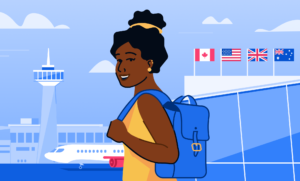After months of preparation and anticipation, it can feel frustrating to receive a Canadian student visa rejection. Thankfully, you always have the option to reapply and try again! If you’re pursuing study abroad in Canada, there are some ground rules to follow when reapplying for a Canadian student visa (also known as a study permit). Read on for some Canada visa rejection reasons, as well as some helpful tips and tricks to keep in mind.

Refusal or Return
Before we begin, it’s important to distinguish between a visa refusal and a visa return. A visa refusal comes with a letter which explains why your visa was refused.
Canada Visa Rejection Reasons
Reasons for a visa refusal may include:
- Insufficient finances
- Dual intent
- Missing or incomplete documents
- Failure to meet health, security, or criminal admissibility standards
A visa return, however, indicates that parts of your application or supporting documents are missing or incomplete.
In either case, you cannot enter Canada or take your courses (even online) without receiving your study permit approval first.
For some common dos and don’ts when applying for your Canadian visa, check this article out.

See What Went Wrong
Learn why the rejection happened. Finding out your Canada visa rejection reasons can help identify how to improve your application for next time.
If you were rejected after applying from your home country for your Canadian study permit and visitor visa/electronic travel authorization (eTA), the latter of which will allow you to enter Canada, you’ll usually receive a letter stating the reason for your Canadian student visa rejection.
If you were rejected after receiving your study permit and visitor visa, travelling to Canada, and completing your visa interview at the airport, then you may ask the border services officer for the reasons your final study permit was refused.
Common reasons for refusal include:
- Insufficient proof that you have enough money to support yourself while studying in Canada
- Failure to convince the visa officer that your main purpose of travel to Canada is to study
- Failure to convince the visa officer that you will leave at the end of the study period
- Incomplete or false documents
- Inadequate language or communication skills
Here are five top reasons for Canadian student visa rejection. Don’t let one of them happen to you
At the end of the day, it’s important for the visa officials who issue your final study permit (which allows you to stay in Canada and study) to know you’re telling the truth and that you respect your student visa’s rules and regulations.

Fix Your Visa Application Errors
It’s important to prepare your documentation and get ready for your visa interview well in advance. This will give you time to think through your answers and assemble the necessary documentation.
Read this article for a list of documents you’ll need to apply for a Canadian student visa.
Here are some general rules to keep in mind when starting your next application:
- Ensure your finances are in order, and you have all the money necessary documents from your financial institution.
- Check all your documentation thoroughly, and have someone else check it as well, if possible.
- During your interview with the border services officer, explicitly mention you will return back home after your studies end.
- Know details about your institution of choice, including the program you’ve selected and the campus.
- Practice for your visa interview.
Want to ace your Canadian visa interview? Take a look at this blog for some tips and strategies!

Options for Reapplying
When reapplying for a student visa, you generally have two options:
- Reapply in the same country
- Reapply in a different country
Now is a good time to re-analyze your priorities in terms of where you want to study, and either change course slightly or try again.

In the Same Country
After finding out their Canada visa rejection reasons, many students learn from their mistakes when applying for their first visa, and are successful after fixing any errors. You may want to reapply in the same country if:
- You’ve already been accepted to your dream academic institution.
- You have family and friends living there.
- It’s your most cost-effective option (through scholarships or accommodations).
Not sure where you want to study abroad? This article can help you narrow down your options.
If your first application was rejected due to specific documentation errors or omissions, resolve the reasons for your rejection before reapplying. Or, if your visa application was rejected after your visa interview, ask the border services officer for the reason, and correct those issues when you reapply.
You must remain in the airport if you fail the visa interview until you can return to your home country—so we strongly recommend preparing adequately for it!

In a Different Country
Sometimes, rejection can be a redirection. There are many high-quality institutions in all our destination countries, with plenty of unique benefits. If after some thought, you decide to study in a different destination, narrow down your options further to suit your needs. Whether you study in Canada, the US, the UK, or Australia, you can find your dream institution!

While Waiting
Whether you decide to reapply now or in the future, it’s always a great idea to use the time you have while waiting to add extra qualifications to your resume. This increases your chances of having your student visa accepted, and can motivate you to continue pursuing your goals.
You can strengthen your resume by:
- Joining a club or team
- Volunteering
- Taking on new responsibilities at work
- Attending networking events
Looking to improve your resume? This article highlights more options.
The reality is that sometimes, students have to deal with a Canadian student visa rejection. However, there are always solutions, and one rejection shouldn’t be a reason to give up on your study abroad dreams!
Ready to regroup and apply again? Explore your options on the ApplyBoard Platform!



